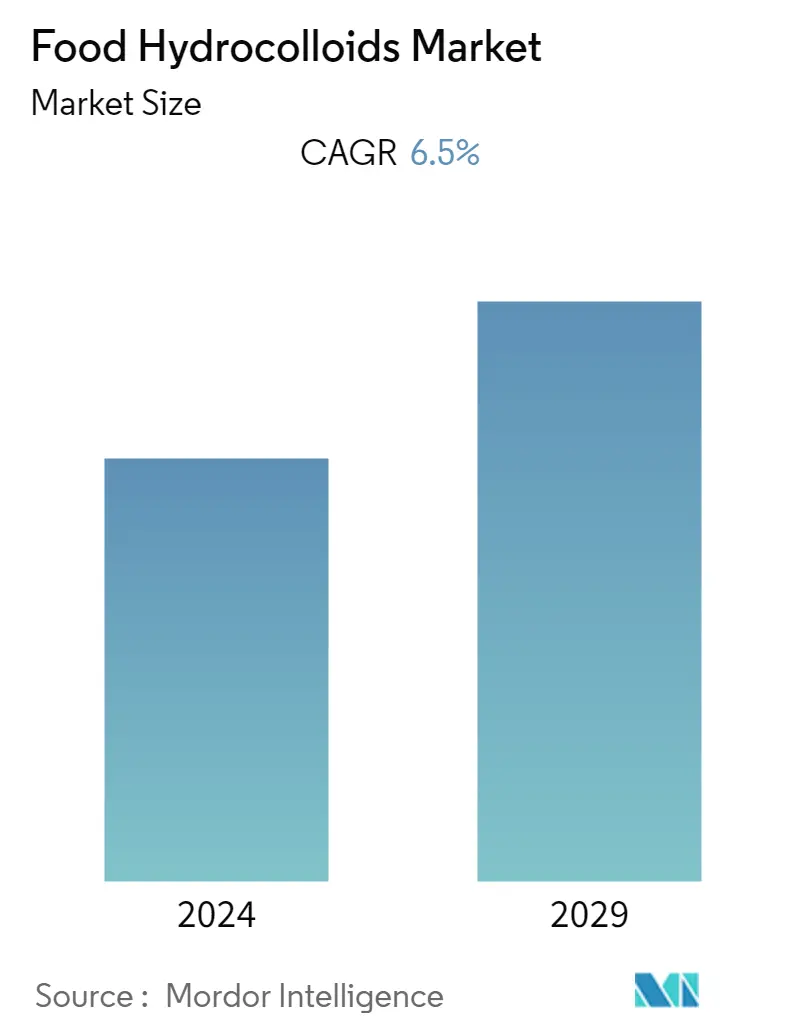Market Size of Food Hydrocolloids Industry

| Study Period | 2019 - 2029 |
| Base Year For Estimation | 2023 |
| CAGR | 6.50 % |
| Fastest Growing Market | Asia Pacific |
| Largest Market | North America |
| Market Concentration | High |
Major Players
*Disclaimer: Major Players sorted in no particular order |
Food Hydrocolloids Market Analysis
The global food hydrocolloids market is estimated to register a CAGR of 6.5% during the forecast period, (2021-2026).
The market was affected marginally by COVID-19. Considering the pandemic scenario, it negatively impacted the demand for various hydrocolloids from the respective food and drink sector, which witnessed the downfall. Moreover, the pandemic had caused a drop in the overall demand for on-the-go foods and beverages, for the short term. For instance, in the Europe Union (EU-27), according to FoodDrinkEurope, in Q2 2020, the region's food and drink industry production decreased by 9.6% compared to the previous quarter and decreased by 9.1% Y-o-Y compared to Q2 2019.
However, increasing consumer preference for online purchasing for various foods and beverages containing hydrocolloids, during the pandemic, is likely to enhance the demand for market studied.
Increasing demand for processed and convenience food products is likely to act as opportunities for the studied market during the forecast period. Moroever, over the short term, growing demand in the food and beverage industry and increased R&D and innovations in hydrocolloids are expected to drive the market's growth.
On the flipside, adherence to international quality standards and regulations and unfavorable conditions arising due to the COVID-19 pandemic are likely to hinder the growth of hydrocolloids market.
Food Hydrocolloids Industry Segmentation
Hydrocolloids are a class of food ingredients that are widely used in the development of food structures. In other words, hydrocolloids are most simply water-soluble polymers that contribute viscosity and gelation in solution. The global food hydrocolloids market is segmented by type, application, and geography. Based on type, the market has been further segmented into gelatin gum, pectin, xanthan gum, guar gum, carrageenan, and other types, while based on application, it has been segmented into dairy and frozen products, bakery, beverages, confectionery, meat and seafood products, oils and fats, and other applications. By geography, the market is segmented into North America, Europe, Asia-Pacific, South America, Middle East and Africa. For each segment, the market sizing and forecasts have been done on the basis of revenue (USD million).
| Type | |
| Gelatin Gum | |
| Pectin | |
| Xanthan Gum | |
| Guar Gum | |
| Carrageenan | |
| Other Types |
| Application | |
| Dairy and Frozen Products | |
| Bakery | |
| Beverages | |
| Confectionery | |
| Meat and Seafood Products | |
| Oils and Fats | |
| Other Applications |
| Geography | |||||||||
| |||||||||
| |||||||||
| |||||||||
| |||||||||
|
Food Hydrocolloids Market Size Summary
The food hydrocolloids market is poised for significant growth, driven by increasing consumer demand for processed and convenience foods. The market experienced a slight downturn due to the COVID-19 pandemic, which temporarily reduced demand in the food and beverage sector. However, the shift towards online purchasing during the pandemic has bolstered demand for hydrocolloid-containing products. The bakery and confectionery industries benefit from hydrocolloids by enhancing food freshness and reducing staling, which aligns with the growing consumer preference for indulgence and convenience. The Asia-Pacific region, particularly China and Japan, is a key player in the market, with China being a major manufacturer and consumer, especially in the dairy sector.
The competitive landscape of the food hydrocolloids market is marked by the presence of several major players, including DowDuPont and Cargill, who focus on innovative solutions to improve the taste, texture, and nutritional value of processed foods. The market is further supported by strategic investments and product launches, such as Ingredion's addition of single hydrocolloids to its portfolio and CP Kelco's introduction of clean-label-friendly ingredients. These developments cater to the rising global demand for label-friendly and versatile hydrocolloids in various food applications, including fruit preparations, dairy, confectionery, and bakery products.
Food Hydrocolloids Market Size - Table of Contents
-
1. MARKET DYNAMICS
-
1.1 Market Drivers
-
1.2 Market Restraints
-
1.3 Porter's Five Forces Analysis
-
1.3.1 Threat of New Entrants
-
1.3.2 Bargaining Power of Buyers/Consumers
-
1.3.3 Bargaining Power of Suppliers
-
1.3.4 Threat of Substitute Products
-
1.3.5 Intensity of Competitive Rivalry
-
-
-
2. MARKET SEGMENTATION
-
2.1 Type
-
2.1.1 Gelatin Gum
-
2.1.2 Pectin
-
2.1.3 Xanthan Gum
-
2.1.4 Guar Gum
-
2.1.5 Carrageenan
-
2.1.6 Other Types
-
-
2.2 Application
-
2.2.1 Dairy and Frozen Products
-
2.2.2 Bakery
-
2.2.3 Beverages
-
2.2.4 Confectionery
-
2.2.5 Meat and Seafood Products
-
2.2.6 Oils and Fats
-
2.2.7 Other Applications
-
-
2.3 Geography
-
2.3.1 North America
-
2.3.1.1 United States
-
2.3.1.2 Canada
-
2.3.1.3 Mexico
-
2.3.1.4 Rest of North America
-
-
2.3.2 Europe
-
2.3.2.1 Spain
-
2.3.2.2 United Kingdom
-
2.3.2.3 Germany
-
2.3.2.4 France
-
2.3.2.5 Italy
-
2.3.2.6 Russia
-
2.3.2.7 Rest of Europe
-
-
2.3.3 Asia-Pacific
-
2.3.3.1 China
-
2.3.3.2 Japan
-
2.3.3.3 India
-
2.3.3.4 Australia
-
2.3.3.5 Rest of Asia-Pacific
-
-
2.3.4 South America
-
2.3.4.1 Brazil
-
2.3.4.2 Argentina
-
2.3.4.3 Rest of South America
-
-
2.3.5 Middle East & Africa
-
2.3.5.1 South Africa
-
2.3.5.2 United Arab Emirates
-
2.3.5.3 Rest of Middle East & Africa
-
-
-
Food Hydrocolloids Market Size FAQs
What is the current Food Hydrocolloids Market size?
The Food Hydrocolloids Market is projected to register a CAGR of 6.5% during the forecast period (2024-2029)
Who are the key players in Food Hydrocolloids Market?
Cargill Incorporated, CP Kelco US Inc., DuPont, Koninklijke DSM N.V. and Archer Daniels Midland Company are the major companies operating in the Food Hydrocolloids Market.

